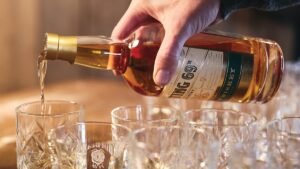
This Is the Difference Between Bourbon and Whiskey
If you’re not someone who drinks a lot of brown liquor, the difference between bourbon and whiskey might not seem all that apparent. After all, both bourbon and whiskey are brown liquids — they look about the same. And to add to the possible confusion, if you just refer to bourbon as whiskey, you wouldn’t be wrong. Bourbon is a type of whiskey, much the way that Champagne is a type of wine. So all bourbon is whiskey, but not all whiskey is bourbon.
:max_bytes(150000):strip_icc():format(webp)/scotch-bourbon-joint-tariff-statement-FT-BLOG0120-2000-65ec814d31e544babeb59d38fcf53d71.jpg)
Bourbon is made with at least 51% corn
What makes bourbon distinct from other whiskeys is the way it is manufactured and aged. All whiskey is spirit made from fermented grain and then aged in barrels. But the kind of grain and the kind of barrels determines the variety of whiskey. Per the American Bourbon Association, in order to be classified as bourbon, a whiskey needs to be distilled from a mixture of grains, or mash, that’s at least 51% corn. That corn gives bourbon its distinctive sweet flavor.
Bourbon is always aged in new charred oak barrels
Bourbon also must be aged in new charred oak barrels, and cannot include any additives or colorings. Other whiskeys can be aged in barrels previously used to age other spirits, and they don’t necessarily need to be whiskey barrels — port, sherry, and rum casks are used in the aging process for non-bourbon whiskeys. To be designated “straight bourbon whiskey,” bourbon has to have been aged in new charred oak barrels for a minimum of two years.
Bourbon has to hit certain ABV marks
When bourbon is barreled, it also has to hit a certain proof or alcohol content in the spirit. The mash must be distilled at 160 proof (or 80% alcohol by volume) or less, and aged in barrels until it is no more than 125 proof (62.5% alcohol by volume) or less. Before bottling, bourbon is filtered and diluted down to no less than 80 proof (40% alcohol by volume). Other whiskeys have different ABV standards for barreling and distilling. The minimum bottling strength for Scotch whiskey, for example, is also 80 proof or 40% ABV, but there is no maximum or minimum ABV for the distillate.
Bourbon doesn’t need to come from Kentucky (but it probably does)
You may have heard that in order to be a bourbon, the whiskey has to be from Kentucky. That’s not quite true — bourbon can be made outside that state. But to be designated a “Kentucky bourbon,” the spirit has to be both distilled and aged in Kentucky. The name “bourbon” even comes from old Bourbon, what is now Bourbon County, Kentucky. Most bourbon is made in Kentucky, but not all, so it has become synonymous with the spirit, much as the Champagne region in France is synonymous with champagne, even though sparkling wine using similar methods is produced elsewhere. So next time you order a bourbon, you know that what you’ll be getting in your glass isn’t just a whiskey, but a specific (and delicious) kind of whiskey.
Related Projects
Learn to Taste Whiskey Like a Pro
I am always trying to enhance my palate to offer my clients a better experience each and every time I speak to them during a whiskey, tequila, mezcal, or gin tasting. For example, something I thoroughly enjoy in tasting gin is pulling out the different botanicals...
Read More
Whiskeys
April 13, 2024
Why You Shouldn't Add Cold Water to Your Whiskey
Why You Shouldn't Add Cold Water to Your Whiskey
The subject of whether or not a whiskey drinker should add water to their dram while tasting has been debated time and time again. But one detail within that topic that's often left undiscussed is how the temperature of that water affects one's perception of a...
Read More
Whiskeys
April 13, 2024
Single Malt and Blended Whisky — What's the Difference?
Single Malt and Blended Whisky — What's the Difference?
A couple of years ago, I had the opportunity to blend my own single malt Scotch whisky using components that were sent to me by Bruichladdich, whose famously un-peated flagship expression, known as The Classic Laddie, is a staple in my own home....
Read More



